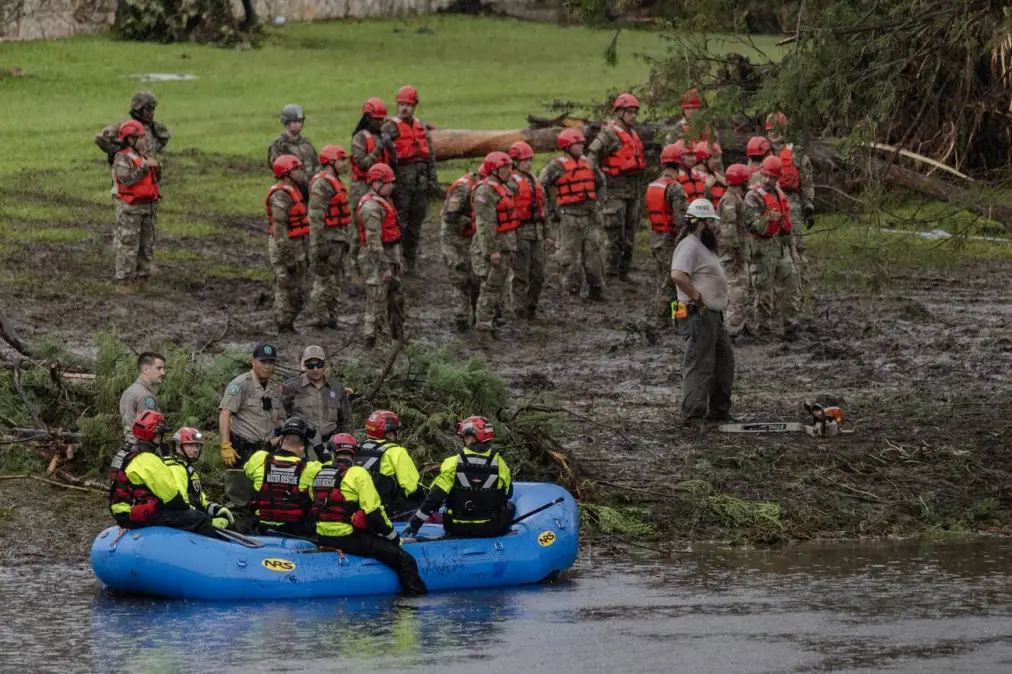As other states rally to aid Texas flood recovery efforts, officials demand answers

In the wake of catastrophic flash flooding in Central Texas that has left at least 120 people dead and 170 missing, several states, including North Dakota and California, are stepping in to help.
Gov. Kelly Armstrong on Thursday authorized the North Dakota National Guard to send a seven-member crew to operate an MQ-9 Reaper drone to help look for survivors as part of an interstate mutual aid agreement. The mission is being carried out under the Emergency Management Assistance Compact, a national system that allows states to share personnel and resources during emergencies.
According to Armstrong’s office, this is the first time North Dakota’s Guard has deployed the drone in response to an EMAC request.
“Other states have come to our aid in extremely challenging times, and North Dakota stands ready to help Texas through this catastrophe however we can,” Armstrong said.
The MQ-9 Reaper, controlled remotely from Fargo by the North Dakota Air National Guard’s 119th Wing, is being used to provide aerial surveillance, search for missing people and help assess damage in areas that remain dangerous or inaccessible.
California is also lending its resources to Texas recovery efforts.
Gov. Gavin Newsom on Wednesday sent personnel from the state’s Urban Search and Rescue task forces to assist with search and rescue, along with an Incident Support Team with planning and coordination expertise.
Utah is sending personnel from the National Guard and the Highway Patrol to assist with border security.
Several other states, including Arkansas, Florida, Louisiana, Nebraska, New Jersey, Ohio, Oklahoma, South Carolina, Tennessee, Virginia and Wisconsin, are also providing resources, according to an update from Texas Gov. Greg Abbott’s office.
As extreme weather events become more common, officials say this kind of interstate collaboration is vital.
During a call with reporters on Thursday, Deanne Criswell, a former administrator at the Federal Emergency Management Agency, emphasized the importance of partnerships between local, state and federal entities for emergency management. She also highlighted the need for federal support due to climate change.
“One of the core principles is that these types of events are always locally executed, state managed and federally supported,” Criswell said of the response to the Texas flooding. “We shouldn’t be asking state and local emergency managers to do this on their own. We shouldn’t be asking states to replicate the capability that the federal government can bring. That’s not a good use of taxpayer dollars.”
Criswell also stressed the urgency of investing in resilience and infrastructure to prevent future disasters, noting the availability of funds and the critical role of FEMA in disaster recovery.
Texas State Sen. Roland Gutierrez, also on the call, criticized President Donald Trump’s administration for its cuts to the National Weather Service and FEMA, which he said exacerbated the recent Texas flooding.
“What happened in rural Texas a week ago was absolutely a malfeasance on the part of the state of Texas, and absolutely just a complete abrogation of the responsibility of the federal government when you have a president that eliminates 600 jobs from the National Weather Service,” said Gutierrez.
Since January, the Trump administration has cut more than 200 employees from FEMA and more than 1,000 employees from the National Oceanic Atmospheric Administration, which houses NWS. The firings are part of the Trump administration’s broader effort to downsize the federal government. Some reports suggest that about 2,000 full-time FEMA staff have been terminated or voluntarily left the agency since the start of Trump’s second term.
According to the Texas comptroller’s office, the state is projected to have a $24 billion surplus in its biennial budget. Gutierrez said that’s more than enough money to cover previously dismissed proposals for a flood-warning system in rural communities, including outdoor sirens and river gauges. Kerr County, which was hit hard by the floods, had discussed buying water gauges and sirens after previous flood disasters in 2017, but, as with many rural Texas counties, cost was an issue.
“It would cost the state of Texas budget dust — nothing. Even if it cost a half a billion dollars, that’s nothing to a state that’s sitting on over $24 billion right now in surplus,” he said. “The people that are managing the purse strings, they don’t want to do the very bare minimum.”
This week, Gov. Abbott called for a special legislative session to begin on July 21. Legislation to improve early warning systems and other preparedness infrastructure in flood-prone areas throughout Texas is on the agenda.
“We delivered on historic legislation in the 89th Regular Legislative Session that will benefit Texans for generations to come,” Abbott said in the announcement. “There is more work to be done, particularly in the aftermath of the devastating floods in the Texas Hill Country. We must ensure better preparation for such events in the future.”





